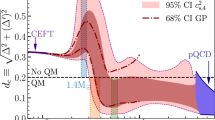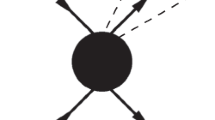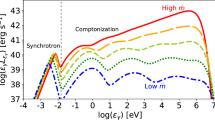Abstract
COLGATE AND WHITE1 have proposed that neutrinos could transport energy outwards during the gravitational collapse of a star, thus initiating a supernova explosion. Detailed calculations by Wilson2 seemed to rule out this possibility, but Freedman3 pointed out in the context of unified gauge theories of weak and electromagnetic interactions that there could be both a large neutrino–neutron elastic scattering cross section and a very large coherent neutrino–heavy nucleus cross section. Wilson4 has recently recalculated the collapse of an iron core formed at the end of a stellar evolution from massive stars and shown that the calculations do simulate an explosion, and that a stronger explosion results from smaller coherent scattering off heavy nuclei. This surprising result arises because a smaller cross section allows more neutrinos to escape, lowering the pressure and thereby letting the neutron core reach a higher density before the outward shock wave is formed. We have calculated neutrino–nucleon and neutrino–heavy nucleus neutral current cross sections in weak SU(2)×U(1) and compared with those of the standard unified theory. Important differences are found which could make simulated supernova explosions easier to obtain. Possible experiments to test the two theories are outlined here.
This is a preview of subscription content, access via your institution
Access options
Subscribe to this journal
Receive 51 print issues and online access
$199.00 per year
only $3.90 per issue
Buy this article
- Purchase on Springer Link
- Instant access to full article PDF
Prices may be subject to local taxes which are calculated during checkout
Similar content being viewed by others
References
Colgate, S. A. & White, R. A. Astrophys. J. 143, 626 (1966).
Wilson, J. R. Astrophys. J. 163, 209 (1971).
Freedman, D. Z. Phys. Rev. D 9, 1389 (1974).
Wilson, J. R. Stellar Collapse and Supernovae (University of California, Lawrence Liver-more Lab. Rep., UCRL-80167, 1978).
Weinberg, S. Phys. Rev. Lett. 19, 1264 (1967).
Tubbs, D. L. & Schramm, D. N. Astrophys. J. 201, 467 (1975).
Lamb, D. Q. & Pethick, C. J. Astrophys. J. 209, L73 (1976).
Bailin, D. & Dombey, N. Nature 271, 20 (1978).
Fortson, E. N. Proc. Int. Conf. Neutrino Phys. Neutrino Astrophys. (to be published).
Adler, S. L. et al. Phys. Rev. D 11, 3309 (1975).
Prescott, C. Y. et al. Phys. Lett. 77 B, 347 (1978).
Author information
Authors and Affiliations
Rights and permissions
About this article
Cite this article
BAILIN, D., DOMBEY, N. Low energy neutrino elastic scattering and supernova explosions. Nature 275, 300–301 (1978). https://doi.org/10.1038/275300a0
Received:
Accepted:
Issue Date:
DOI: https://doi.org/10.1038/275300a0
Comments
By submitting a comment you agree to abide by our Terms and Community Guidelines. If you find something abusive or that does not comply with our terms or guidelines please flag it as inappropriate.



